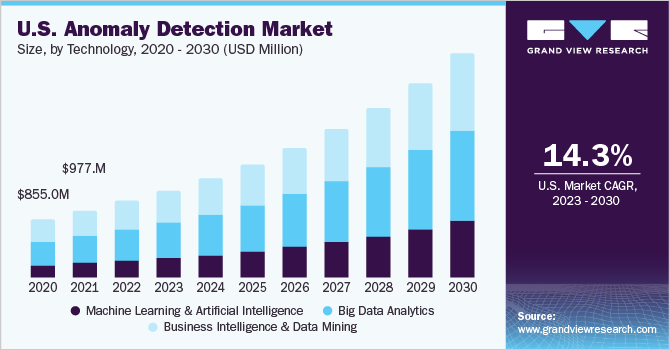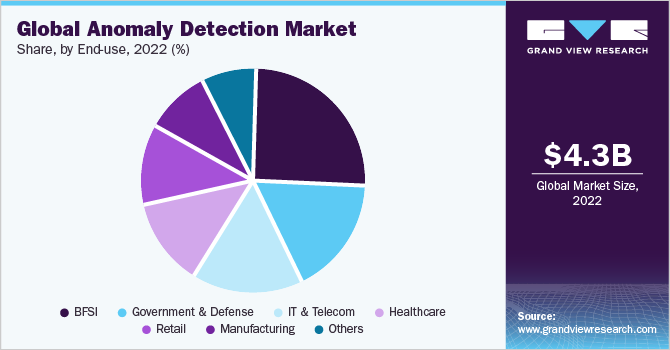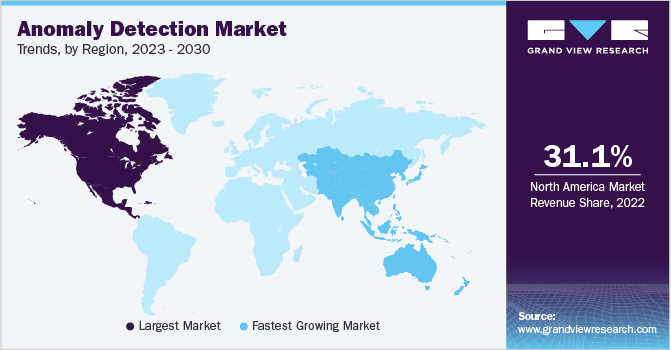
Anomaly Detection Market Size, Share & Trends Analysis Report By Deployment (Cloud, On-premise), By Component (Solution, Services), By Technology (Big Data Analytics, ML & AI), By End-use (BFSI, Retail), And Segment Forecasts, 2023 - 2030
- Report ID: GVR-4-68040-092-0
- Number of Pages: 100
- Format: Electronic (PDF)
- Historical Range: 2018 - 2021
- Industry:Technology
Report Overview
The globalanomaly detection market sizewas valued atUSD 4.33 billion in 2022and is expected to grow at a compound annual growth rate (CAGR) of 16.5% from 2023 to 2030. The growing sophistication and complexity of cyber-attacks are one of the factors driving the growth of the market. With the growing frequency and intricate nature of threats, the traditional approaches to detecting and monitoring cyberattacks often need to be revised compared to modern approaches. Anomaly detection offers a proactive defense approach allowing the organization to identify and respond to unforeseen threats. The exponential growth of technology advancements and databases inMachine Learning(ML) has made it viable for organizations to analyze huge datasets in real-time.

By using ML algorithms to analyze enormous volumes of data, anomaly detection can find trends and anomalies that may be signs of online threats. The implementation of anomaly detection in cybersecurity has increased due to the availability of scalable and effective ML techniques. The overall security posture can be improved by integrating anomaly detection into Security Operations Centres (SOCs) and incident response procedures. Security analysts can efficiently prioritize and react to potential risks because of the real-time warnings and actionable insights it delivers. Furthermore, organizational security is significantly at risk from insider threats. An employee’s or authorized user’s unexpected behavior can be found using anomaly detection, including unauthorized access to sensitive information, strange file transfers, and unusual network traffic.
Organizations can reduce the risk of insider threats and safeguard their important assets by tracking user behavior and spotting irregularities. Organizations can comply with compliance requirements and stay out of trouble owing to anomaly detection, which assists them in monitoring and detecting security incidents or data breaches. It offers an extra layer of security to secure sensitive data and guarantee regulatory compliance. This is expected to propel the market demand across regions over the forecast period. Moreover, cyber threats and attacks significantly increased as a result of the pandemic as malicious players took advantage of the unstable and exposed environment.
Phishing attempts, ransomware assaults, and other cybercrimes increased dramatically, putting organizations throughout the world at risk. The need for anomaly detection solutions has increased as a result of the growing threat concerns as organizations are seeking advanced methods to identify and counteract developing cyber threats. However, effective implementation and management of anomaly detection systems can be challenging. It can be difficult to configure and optimize these systems so that they discover real anomalies while minimizing false positives (false alarms). High false positive rates might erode trust in the system’s accuracy and cause alert fatigue, which may hinder product adoption.
Component Insights
The solutions segment accounted for the largest market share of 69.0% in 2022. The cybersecurity threat landscape is constantly changing with more sophisticated and advanced threats. Through the detection of unusual trends or behaviors, anomaly detection solutions offer a proactive method for identifying new or evolving threats. Massive datasets can be processed and analyzed by anomaly detection tools, which can then be used to find hidden patterns and identify anomalies that could be signs of security vulnerabilities. The effectiveness and adoption of anomaly detection technologies have been strongly influenced by their ability to handle enormous amounts of data. The proliferation and complexity of cyber threats drive the need for efficient anomaly detection solutions, thereby driving industry growth.
The services segment is expected to grow at the fastest CAGR of 17.6% over the forecast period.Cloud computingand managed security services are now much more widely used across organizations. Anomaly detection services are frequently included in managed or cloud-based security service packages. These services offer businesses a hassle-free, cost-effective way to set up and maintain anomaly detection capabilities. Organizations can concentrate on their core operations while assuring reliable anomaly detection by leveraging the knowledge and infrastructure of service providers, thereby propelling the demand.
Deployment Insights
The on-premise segment accounted for the largest share of 54.9% in 2022. Organizations frequently need to have direct and auditable control over their data processing and security procedures to comply with industry-specific legislation. By ensuring that data stays on the premises while remaining under direct control, on-premise anomaly detection helps organizations comply with legal and regulatory requirements.Organizations can handle and analyze data locally using on-premise anomaly detection rather than relying on external networks or cloud infrastructure, which is further helping drive segmental growth.
The cloud segment is expected to grow at a CAGR of 17.8% from 2023 to 2030. The versatility and scalability of cloud-based anomaly detection technologies are unmatched. Anomaly detection capabilities may be readily scaled up or down by organizations based on their demands owing to cloud infrastructure. Organizations don’t need to make significant infrastructure expenditures or plan for capacity as data volumes and processing need to change over time; as a result, they may dynamically modify their resources. Because of its flexibility and scalability, cloud-based anomaly detection is a desirable choice for businesses with varied workloads or quickly shifting data environments.
Technology Insights
The big data analytics segment accounted for the largest share of more than 40.9% in 2022. Organizations are producing and gathering enormous volumes of data from numerous sources due to the expansion of digital technology and connected devices. Since this data comes in both structured and unstructured as well as semi-structured formats, manually identifying abnormalities can be difficult. Big data analytics anomaly detection enables businesses to quickly scan and examine enormous amounts of data, discovering unexpected patterns or behaviors that might point to security issues or strange actions.
The machine learning &artificial intelligencesegment is expected to witness significant growth at a CAGR of 18.7% from 2023 to 2030. Organizations can recognize and respond to abnormalities as they occur due to real-time ML and AI-based anomaly detection models. In time-sensitive situations like fraud detection, network security, or system monitoring, real-time anomaly detection is essential. ML and AI algorithms can handle streaming data or conduct analysis in close to real-time, enabling businesses to move quickly and lessen the effect of abnormalities.
End-use Insights
The BFSI segment accounted for the largest share of 26.0% in 2022. The BFSI sector’s important component is risk management. Identification of potential hazards, such as credit risk, market risk, operational risk, and fraud risk, is made possible via anomaly detection. Organizations can assess and mitigate risks, make wise decisions, and reduce financial losses by spotting abnormalities in financial transactions, consumer behavior, or market patterns. Organizations in the BFSI sector can reduce financial risks, protect client assets, and uphold consumer trust and confidence by utilizing anomaly detection strategies. The IT & telecom segment is expected to grow at a CAGR of 18.7% over the forecast period. Various types of fraud, such as telecom fraud, identity theft, and financial fraud, are common in the IT and telecom industries.

Unusual call volumes, strange user behavior, or dubious financial transactions are just a few examples of patterns that anomaly detection algorithms can identify as being indicative of fraudulent activity. Employing anomaly detection solutions enables organizations to detect and prevent fraud attempts, protecting both their own interests and the data of their clients. Furthermore, by identifying unexpected network traffic patterns, network abnormalities, or unauthorized access attempts, anomaly detection systems help organizations spot potential network intrusions and take appropriate action. Organizations can prevent or lessen the effect of security breaches by seeing irregularities in real-time, thereby supporting the growth of the market.
Regional Insights
The North America region dominated the global market in 2022 with a revenue share of 31.1%. A rapidly changing, unsafe environment, particularly in terms of cybersecurity, affects the North American continent. Furthermore, organizations are producing and gathering enormous volumes of data because of the spread of digital technology and the emergence of big data. Financial, insurance, e-commerce, and healthcare industries, among others, all depend on anomaly detection to identify fraudulent activity. Businesses can proactively identify and reduce fraud risks by looking for trends and abnormalities in transactional data or user behavior. Asia Pacific is anticipated to register the fastest CAGR of 18.0% over the forecast period.

在线交易激增,e-commerce activities, and digital services, the digital economy has rapidly expanded across the Asia Pacific region. The demand for anomaly detection to detect and address potential fraud, security breaches, and other irregularities in these digital transactions has increased as a result of this expansion. With the growing banking services, fintech developments, and an increase in digital payments, the Asia Pacific financial services industry is rising significantly. For Anti-Money Laundering (AML) initiatives, fraud detection, and regulatory compliance in this industry, anomaly detection is essential. Anomaly detection assists in identifying potential fraudulent actions and ensures compliance with financial legislation by examining transactional data and user behavior.
Key Companies & Market Share Insights
公司利用各种无机增长助教ctics, such as partnerships, regular mergers, and acquisitions, to broaden their product offerings. For instance, in April 2022, HPE launched an HPE Swarm Learning solution, to enhance the accuracy and lessen biases in AI model training, without compromising any data security. The product is one of the advanced approaches to AI, which allows to detect global challenges, such as enhanced anomaly detection and improved patient healthcare, which aids in offering predictive maintenance and fraud detection. Prominent players operating in the global anomaly detection market include:
Amazon Web Services, Inc.
Anodot Ltd.
博通,Inc.
Cisco Systems, Inc.
戴尔的技术公司。
Dynatrace, LLC
GURUCUL
Happiest Minds
Hewlett Packard Enterprise Company
International Business Machines Corp.
LogRhythm, Inc.
Microsoft Corp.
SAS Institute, Inc.
Splunk, Inc.
Trend Micro, Inc.
Anomaly Detection Market Report Scope
Report Attribute |
Details |
Market size value in 2023 |
USD 5.02 billion |
Revenue forecast in 2030 |
USD 14.59 billion |
Growth Rate |
CAGR of 16.5% from 2023 to 2030 |
Base year for estimation |
2022 |
Historical data |
2018 - 2021 |
Forecast period |
2023 - 2030 |
Quantitative units |
Revenue in USD billion and CAGR from 2023 to 2030 |
Report coverage |
Revenue forecast, company market share, competitive landscape, growth factors, and trends |
Segments covered |
Component, deployment, technology, end-use, region |
Regional scope |
North America; Europe; Asia Pacific; Latin America; Middle East & Africa |
Country scope |
U.S.; Canada; Germany; UK; France; Italy; Spain; China; India; Japan; South Korea; Australia; Brazil; Mexico; Argentina; UAE; Saudi Arabia; South Africa |
Key companies profiled |
亚马逊网络服务公司。Anodot有限公司;博通,Inc.; Cisco Systems, Inc.; Dell Technologies, Inc.; Dynatrace, LLC; GURUCUL; Happiest Minds; Hewlett Packard Enterprise Company; International Business Machines Corp.; LogRhythm, Inc.; Microsoft Corp.; SAS Institute, Inc.; Splunk, Inc.; Trend Micro, Inc. |
Customization scope |
Free report customization (equivalent to up to 8 analysts working days) with purchase. Addition or alteration to country, regional & segment scope |
Pricing and purchase options |
Avail customized purchase options to meet your exact research needs.Explore purchase options |
Global Anomaly Detection Market Report Segmentation
This report forecasts revenue growth and provides an analysis of the latest trends in each of the sub-segments from 2018 to 2030. For this report, Grand View Research has segmented the anomaly detection market based on component, deployment, technology, end-use, and region:
Component Outlook (Revenue, USD Billion, 2018 - 2030)
Solution
Network Behavior Anomaly Detection
User Behavior Anomaly Detection
Services
Professional Services
Managed Services
Deployment Outlook (Revenue, USD Billion, 2018 - 2030)
Cloud
On-Premise
Technology Outlook (Revenue, USD Billion, 2018 - 2030)
Machine Learning & Artificial Intelligence
大数据分析
Business Intelligence & Data Mining
End-use Outlook (Revenue, USD Billion, 2018 - 2030)
BFSI
Retail
IT & Telecom
Healthcare
Manufacturing
Government & Defense
Others
Regional Outlook (Revenue, USD Billion, 2018 - 2030)
North America
U.S.
Canada
Europe
UK
Germany
France
Italy
Spain
Asia Pacific
China
India
Japan
Australia
South Korea
Latin America
Brazil
Mexico
Argentina
Middle East & Africa
UAE
Saudi Arabia
South Africa
Frequently Asked Questions About This Report
b.The global anomaly detection market size was estimated at USD 4.33 billion in 2022 and is expected to reach USD 5.02 billion by 2023.
b.The global anomaly detection market is expected to grow at a compound annual growth rate of 16.5% from 2023 to 2030 to reach USD 14.59 billion by 2030.
b.Solutions dominated the anomaly detection market with a share of 69.0% in 2022. This is attributable to the effectiveness and adoption of anomaly detection technologies owing to their ability to handle enormous amounts of data. The proliferation and complexity of cyber threats drive the need for efficient anomaly detection solutions, thereby driving the growth of the market.
b.he key players operating in the anomaly detection market include Amazon Web Services, Inc., Anodot Ltd., Broadcom, Inc., Cisco Systems, Inc., Dell Technologies, Inc., Dynatrace, LLC., GURUCUL, Happiest Minds, Hewlett Packard Enterprise Company, International Business Machines Corporation, LogRhythm, Inc., Microsoft Corporation, SAS Institute, Inc., Splunk, Inc., and Trend Micro, Inc.
b.The growing advancements in deep learning and machine learning technologies support the anomaly detection market growth. The traditional statistical approaches are being replaced with modern methods such as generative adversarial networks (GAN), variational autoencoders (Vaes), and recurrent neural networks (RNNs), thereby enhancing the identification of anomalies across various systems.





